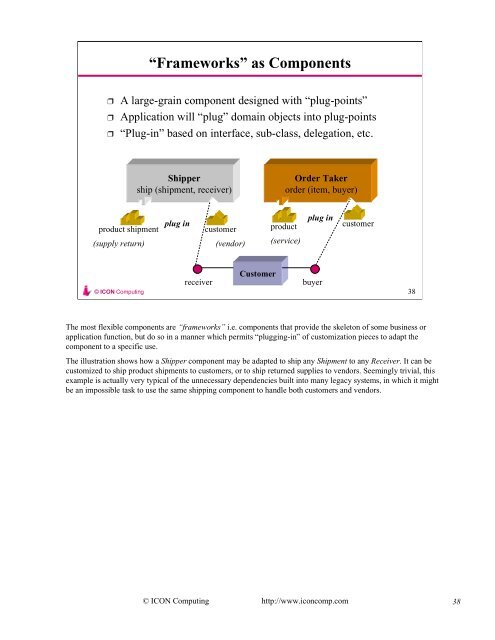Objects, Components, and Frameworks with UML The Catalysis ...
Objects, Components, and Frameworks with UML The Catalysis ...
Objects, Components, and Frameworks with UML The Catalysis ...
Create successful ePaper yourself
Turn your PDF publications into a flip-book with our unique Google optimized e-Paper software.
© ICON Computing<br />
“<strong>Frameworks</strong>” as <strong>Components</strong><br />
❒ A large-grain component designed <strong>with</strong> “plug-points”<br />
❒ Application will “plug” domain objects into plug-points<br />
❒ “Plug-in” based on interface, sub-class, delegation, etc.<br />
Shipper<br />
ship (shipment, receiver)<br />
product shipment<br />
plug in<br />
customer product<br />
(supply return) (vendor) (service)<br />
Order Taker<br />
order (item, buyer)<br />
plug in<br />
Customer<br />
receiver buyer<br />
© ICON Computing http://www.iconcomp.com<br />
customer<br />
<strong>The</strong> most flexible components are “frameworks” i.e. components that provide the skeleton of some business or<br />
application function, but do so in a manner which permits “plugging-in” of customization pieces to adapt the<br />
component to a specific use.<br />
<strong>The</strong> illustration shows how a Shipper component may be adapted to ship any Shipment to any Receiver. It can be<br />
customized to ship product shipments to customers, or to ship returned supplies to vendors. Seemingly trivial, this<br />
example is actually very typical of the unnecessary dependencies built into many legacy systems, in which it might<br />
be an impossible task to use the same shipping component to h<strong>and</strong>le both customers <strong>and</strong> vendors.<br />
38<br />
38


